Last updated on March 5th, 2020 at 05:22 pm
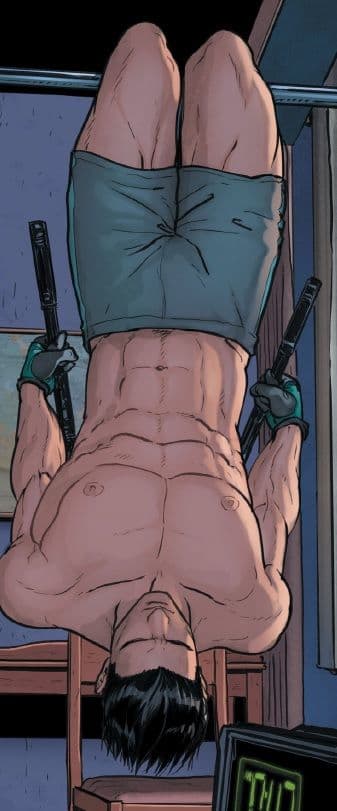 For all you Nightwing lovers out there, this one is for you.
For all you Nightwing lovers out there, this one is for you.
If you don’t already know, we recently released the Bonus Nightwing aka Minimalist Path in The Academy, so I feel this article is extremely well-suited to fit that moving forward.
I get asked all the time “How do I get better at pull-ups?” or “How do I improve my pushups?”, or even “How do I get into calisthenics?!”…
And, to be completely honest, the answer is very similar to training anything else.
In this article we’ll break it down and talk about how to improve specific movements, and even break into calisthenics with some basic bar movements, circuits, and workouts.
What are Calisthenics?
I guess before we get started it would be safe to explain exactly what calisthenics are.
Here’s what we get from good ol’ Google search engine:
cal·is·then·icsˌkaləsˈTHeniks/noun
Basically calisthenics are gymnastic type, bodyweight styled movements.
We saw a lot of this from guys like Stephen Amell, Charlie Hunnam, James Franco and Jason Statham.
We also have an In-Home Bodyweight Routine, and Beginner S.H.I.E.L.D. or DEO Workout as well.
And, for the sake of this article, we’ll be covering some calisthenics circuits, and a bunch of bodyweight movements that can help you get some awesome In-Home Workouts done.
That being said, we’ll also be talking about how to improve very specific workout movements – such as pull-ups, pushups, dips, and more.
If we’re really going to take it up a notch and turn into Nightwing, then we’re going to need a starting point – and this is it.
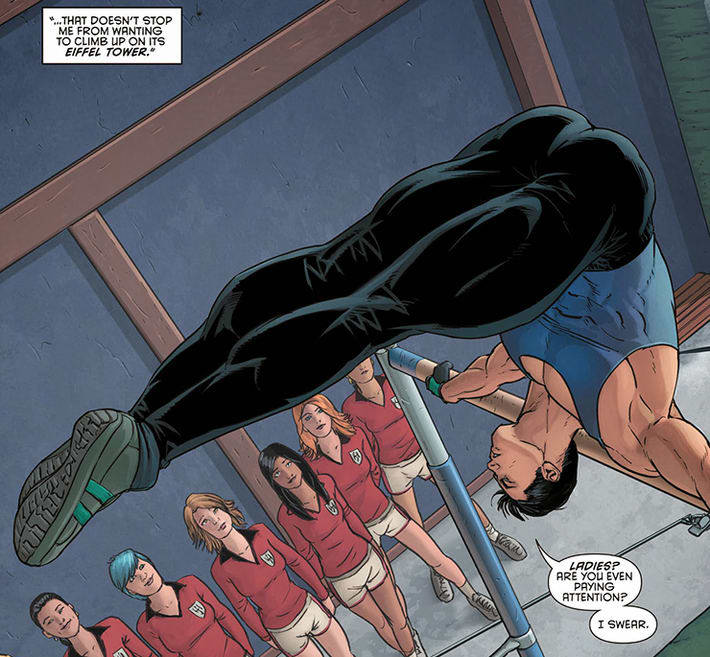
How to get better at Pull-Ups
Starting with pull-ups as a segway into other movements and eventually a calisthenics workout/circuits is the best way to go about this.
We have to start analyzing individual movements before we put them all together.
The trick with these movements really becomes getting started and putting in the work.
It’s much like working out: the hardest part is getting started. From there it’s as simple as finding a program, like we have The Superhero Academy, and then utilizing it and sticking with it.
Progression is key, and so is sustainability. That’s why everything I do is based around how well the SHJ Army can sustain it – including our Nutrition Pillars.
At one point I hated pull-ups…
Now they’re listed as my tied for my favorite movement with deadlifts on my About Me page.
I got better simply by doing them. I never stopped, and eventually I got better and better. Now I can jump up to the bar and bang out 25 easily. Same thing goes for pushups as well.
But what if I can’t do pull-ups right now?
Well, that’s a good question, and definitely something that needs to be discussed.
What we’re going to do for each one of the movements we discuss is also talk about variations and scaling that can be utilized for them to get started.
Some ways you can scale your pull-ups when getting started (remember these for later):
- Assisted pull-ups (band or machine)
- Pull-up negatives
- Pike pushups
So, if you can’t do pull-ups just yet, you’ll be utilizing scaling in order to work your way up. It’s going to take time, so don’t give up if you can’t immediately jump up on the bar and get going.
And then before you know it you’ll be banging out weighted pull-ups, and all sorts of different variations on the bar!
If you don’t want a wall-mounted bar, I suggest something like this to get started in your house.
I currently use this in my townhouse: Pull Up / Dip Station

How to get better at Pushups
Similarly to pull-ups, pushups are something that is going to take putting in some work.
I’ve been doing pushups before bed and sporadically throughout the day since well before I had a gym membership. I’ve always been into fitness, and I was right there with people in not wanting to jump right into a gym environment. Heck, I still work out at home and utilize calisthenics most days. So for me pushups are now extremely natural. I could honestly shoot down on the floor and do 50 clapping pushups in one shot (and I have a video to prove it)!
But, this isn’t to toot my own horn or anything, this is to just point out that it takes work, just like any other movement.
There are tons of different pushups you can eventually do, which makes working out at home a lot of fun, but first we have to get there.
But what if I can’t do pushups right now?
If you can’t do pushups it’s best to scale them like pull-ups until you can eventually feel comfortable doing them.
Some of the scaling I like to use with the SHJ Army can vary depending on the person and what they like, but the good news is you have options.
Some ways you can scale your pushups when getting started (remember these for later):
- Knee pushups
- Pause pushups
- For these you’ll push yourself up from the floor and slowly make your way back down, but eventually lay flat on the ground, pick your hands and feet up for a split second and then proceed to push yourself back up.
- Slow negative pushups
- Plank in the pushup position and then slowly work your way down to the floor. Try to take 5-10 seconds on the way down if you can, and feel your muscles train.
Don’t worry your little Nightwing suit, soon you’ll be doing triangle pushups, clap pushups, wide….heck, even one handed/armed pushups.
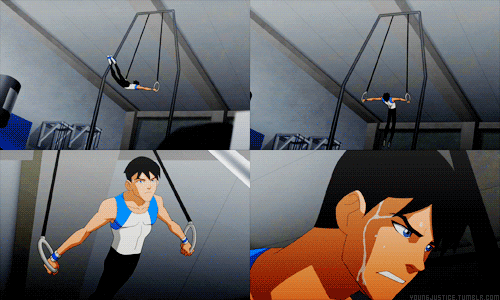
How to get better at Dips and Squats
Without having to be repetitive, I will start by saying that dips and squats are much like pull-ups and pushups. I say that in the sense that you will have to do them in order to get better at them.
The one thing that isn’t the same is that the scaling is a bit different.
They are not specifically scaling exercises as much as I’d recommend just simply making them easier. Eventually you can scale up if you’d like and start performing pistol squats and ring dips, but scaling down is something I generally prefer to just do by making the movements a bit more simple.
The first thing I’d do, even before thinking about scaling them into easier movements is make sure you know exactly how to do each movement.
I’ll talk a bit more about specifics to make every single one of these movements easier and more fluid, but squats in particular should be mastered.
This involves hips a bit further than shoulder length, toes pointed slightly out, and many more steps from here. Here’s a list of what you need to think about when air squatting:
- Keep your weight on your heels.
- Keep your torso upright with your shoulders pulled back.
- Your feet should be hip-width apart with your toes slightly pointing outward.
- Your knees should be over (but not beyond) your toes.
- Your butt, back, and core muscles should be engaged the entire time.
- Raise your arms while squatting down and bring them back to your side on the way up, keeping your shoulders back.
- On the downward portion of the squat, aim to go below parallel.
As for scaling down, I recommend utilizing a chair for both of them.
Chair dips make it nice and easier to walk out or walk in closer or further from the chair to adjust your difficulty. Chair squats allow you to decide how low you’ll be squatting when just starting out. You can sit and stand, or you can more preferably choose to touch your butt to the chair and pop back up.

Tips for improving all these movements
All of these movements, calisthenics and gymnastic styled, share a few commonalities when it comes to improving them. These things are also core attributes you should be working on while doing them in the hopes to get better.
Aside from working hard and continuing to do them, there are some other things I’d like to share with you as well.
Three things you need to be doing to improve your calisthenic/gymnastic movements:
- Keep a tight core at all times
- Squeeze your core tight! It doesn’t matter which movement this is for, like the other tips you’ll find here – this will improve your movement, as well as keep your posture proper.
- Squeeze your glutes
- No, really. Squeeze your glutes while doing these movements as it’s another way to keep your posture tight. This, along with keeping your core tight will ensure a safer movement, as well as work other parts of your body you may have been otherwise neglecting.
- Push the floor or bar away from you
- Think of a screwdriver. We twist it away from us, clockwise. I want you to imagine yourself doing this with your hands while performing these movements. While doing them, you may not be actually twisting your hands or feet, but you’ll be generating your force and power by performing them this way.
These things can also be utilized while performing other movements as well, but it’s extremely important to not neglect them. These are the fundamentals, and foundations for creating improvement and continuing to utilize these calisthenic and gymnastic type movements.
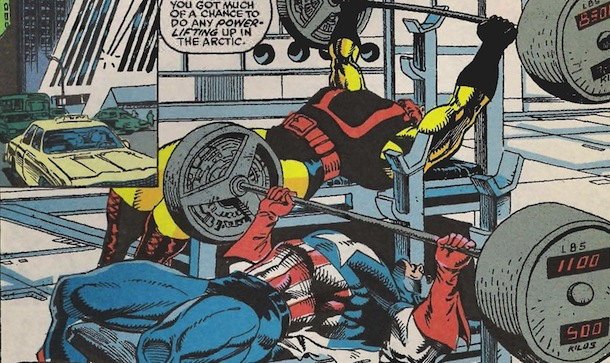
Calisthenic Movements, Workouts and Circuits
When breaking into calisthenics and gymnastic styled training it’s important to remember that it is okay to start with basic scaled movements.
Yes, that means you can go back up through this article and look at the scaling advice I’ve discussed and then utilize it to get through these other workouts, movements and circuits we’ll now discuss in this section.
If that wasn’t obvious enough….
Beginner Calisthenics Workout
We talked about “doing”. Practice makes perfect. So with this beginner workout routine we’ll simply be doing the beginner movements, and utilizing scaling variations if needed.
Perform 50-100 of each movement:
- Pull-up variation
- Pushup variation
- Dips
- Air Squats
These can be broken down into sets of 2, 5, 10, whatever you can handle.
Don’t rush into trying to push yourself for more reps than needed, just put in the work everyday and it will eventually happen. You’ll feel it when you jump up to the bar or down to the floor.
Intermediate Calisthenics Workout
Once you feel you’re at the intermediate level you can begin incorporating other movements into your workouts. These can even be done in circuit styled training to begin also training your endurance and add in some cardio style.
Some of these movements include:
- Burpees
- Planks
- Plank to Pushups
- Hanging Knee Raises
- Pistol Squats
- Harder Variation Pushups
- Weighted Pull-ups
- Jump Squats
- Handstand Pushups
- Muscle Ups
- Wide Grip Pull-ups or Pushups
- And More!
A Sample Styled Circuit Routine could look something like this:
Perform 20 of each movement, and complete 3 rounds for time:
- Plank to Push Ups
- Pull Ups
- Burpees
- Jump Squats
And then you’re on your way to becoming a good ol’ typical Dick Grayson.
I understand it’s not fair to use the word typical in the same sentence as Dick Grayson, and I apologize, but I’m keeping it there anyways.

Closing Thoughts on Calisthenics and Gymnastic Styled Routines
Calisthenic routines can be utilized to amazing success. That’s specifically why the Nightwing Bonus Path is a success on its own, and why we also include an even simpler styled In-Home (Superman/Supergirl) Path in The Academy as well.
There are a few things I want to recommend on top of these styled workouts, though.
If you’re going to be using them as a circuit styled training, the cardio that each movement gives in itself (as far as calorie burning goes) is great in itself.
That being said, I also really like to add in some other forms of cardio into my calisthenics routine as well (though sometimes simply just in the form of burpees, jump squats and other things is more than enough)!
Some of my favorite cheaper options to utilize to add cardio into your home routine:
- A jump rope
- A heavy bag
- A kettlebell
I know Coach Derek would agree with me on all of this, as he talks about how jump roping and a heavy bag are both staples in his training for years now!
But, really, it’s as simple as adding these things into the home gym if you’d like, or not. They’re not needed, but I just like to incorporate them from time to time.
So, to finish off, I suggest going back through this and finding what you’re going to need to scale as you get started, and also take an extra look at how to improve them (as that is extremely important)!
And, if you’d like to step it up a notch and join us in The Superhero Academy, everyone is always welcome and we look forward to seeing you in there!
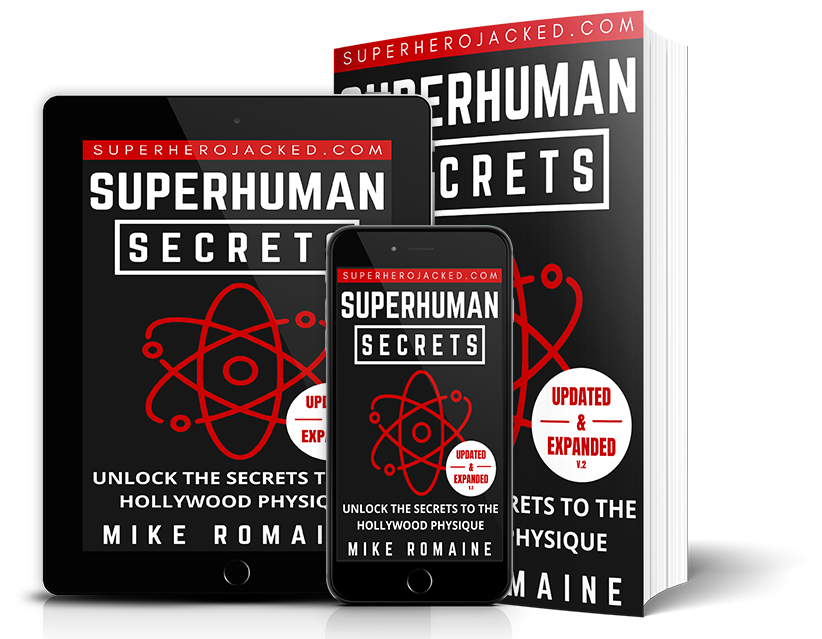
SUPERHUMAN SECRETS V.2
NOW UPDATED AND EXPANDED WITH A NEW SECTION & SEVEN BONUSES
USD$29 USD$14.95

